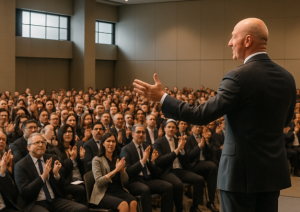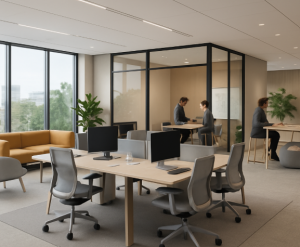Will Safety Supersede Collaboration in the Modern Workspace?
Published on
In June this year, estimates by Fitch Ratings revealed that organizations across the globe may see a revenue slump of more than $5 trillion in 2020 due to the lockdown to curb the spread of the pandemic. Even as early as the second quarter of 2020 you had, on one side of the court, numerous organisations worldwide staring at uncompensated losses.
In contrast, at the other end, you had the minority, such as the All England Club, for whom it was game, set, match. The foresight of the Wimbledon organisers meant that corona virus resulted in earnings to the tune of £114 million in insurance! Similarly, Amazon’s stock managed to rise as home delivery of essentials became a priority. But these gains are deceiving, at best. The world had to forego witnessing a Roger Federer attempt at a 9th Wimbledon title and Amazon had to extend a work-from-home policy till January 2021 to obtain time to navigate through the crisis.
As reality dawns, top-level leadership across the board are pressed to adopt a Wimbledon-like, pandemic-proof foresight and envision what post-COVID-19 work life will look like. At the crux of the issue lies the role that offices are set to play for organizations and if existing spaces need to be redesigned. This is, of course, a question of real estate – organizations have to maintain an adequate square-foot-per-employee ratio – but it is also one of philosophy. For instance, the open-plan office fosters values like transparency and teamwork: are these to be sacrificed for safety? The solution lies not just in altering the philosophy, as COVID-19 forces us all to think in terms of practicality too. After all, an employee across the table sneezing into the open is a definite no-no and leaders need to ensure that such risks are addressed appropriately.
Much of modern-day workspaces are modelled around the need for collaboration: the physical space forms an environment for interaction, idea sharing, and mentoring. But, with safety norms taking centre stage, one wonders whether the office of tomorrow will be forced to draw from principles for hygiene used at hospitals. The opinions are many, but leaders may prefer smaller targeted ‘surgical’ revamps to massive 360° overhauls, which could be rendered unnecessary by the invention of a vaccine. Moreover, not all changes being advocated at present have proven their mettle, which means in-depth assessment is key.
If the lockdown WFH experience is anything to go by, the office is not dead. Rather, collaboration and safety would have to go hand in hand – but how? For that it is apt to take a leaf out of history’s book, look at various workspace designs, note what they mean for collaboration and safety and then, formulate some ideas for the future. Here is our take.
Theory: From Taylorism to the cubicles of the 1980’s and Google
Dedicated offices, such as the Old Admiralty Office, emerged in the 18th century and were more like local shops, notes The Telegraph . Nevertheless, with the invention of communications technology such as the telephone, the office would soon experience the winds of change.
The Taylorist Factory: Prominent in the early 20th century, Frank Taylor, a mechanical engineer, sought to maximise efficiency, with the office being seen as a “machine that could be tuned up to yield better results”, says Jeremy Myerson, the first-ever holder of the Helen Hamlyn Chair of Design at the Royal College of Art. The arrangement was rigid, with rows and rows of desks and managers in encircling offices.
Pros: Collaboration with workers nearby is possible and the spatial arrangement brings structure to the workplace
Cons: Socialization is left out and the packed space means distractions and health hazards
“Bürolandschaft”: This German word means ‘office landscape’ and the philosophy here was to remove spatial hierarchy and improve communication. Enter the open-plan office! These first emerged in the 1950’s and had teams grouped together on one floor with ferns demarcating boundaries.
Pros: Team-wise collaboration is possible; the layout is relaxing, allows for flexibility, and promotes communication
Cons: Unstructured positioning of furniture makes the layout messy and prone to health and hygiene problems
The Cubicle Farm: An offshoot of the Action Office 2.0, the office of the 1980’s resembled a sea of cubicles. Here, felt-covered high walls sequestered employees to their desk and computer. This was an economical way to be productive, but for the employee, the new layout reeked of Taylorism.
Pros: Effectively isolates workers from potential health concerns and eliminates distractions
Cons: Reduced collaboration, and an impaired sense of community and hierarchy
The Modern Office: Imagination is the yardstick for the office of today and Professor Myerson notes that in the networked office, enabled by cloud, mobile technology and so on, “there is a growing uncoupling between the workplace and the work itself.” The post-2010 era has seen everything from lounge seating and sleeping pods to fitness studios and indoor picnic zones.
Pros: Ample scope for collaboration and innovation; employee satisfaction is guaranteed
Cons: Mobile communal shared spaces leave room for hygiene-related problems
This brief review of history provides a few interesting learnings.
1. Collaboration and hygiene quite often find themselves on diametrically opposite sides.
2. Extreme models (think cubicle farms or Taylorist desks) can be dehumanizing.
3. Technological advancements, company workspace philosophy, and employee happiness should together guide workspace design.
Practice: Fast-forwarding office space design amidst a pandemic
In a way, COVID-19 provides a fast-track to the office of tomorrow. It asks all the right questions.
1. How can the Google-inspired office, focused on employee wellbeing keep employees in a happy environment now?
2. If most of one’s work is done alone, is the office chiefly a centre of innovation and collaboration alone? (Note: In the knowledge-based era of today, Professor Myerson points out that you do two-thirds (~66.7%) of your office work alone, without contact with colleagues!)
3. How does one ensure collaboration while steering towards a cubicle-like, virus-thwarting level of security?
The practical measures adopted by organisations world-wide can be categorised into 3 phases, indicates a Steelcase Inc. study:
Present: Involves retrofitting the workspace in accordance with safety compliance requirements
Near: Involves reconfiguring the workspace to house a majority of the workforce
Future: Involves reinventing the workspace according to advancements in science and technology
At present, the focus will be on getting as much of the workforce back to the office, without running the risk of shutting the company down due to an outbreak. As such, some very plausible solutions for the present-day workspace are:
1. Use of materials that can be easily cleaned, multiple times, with agents that are stronger than those used before.
For example, bleach-cleanable fabrics and stone over wood finishes
2. Use of cubicle-forming screen guards or face shields
3. Adoption of sensor-based technology in bathrooms, for instance, for no-touch flushing
4. Shifting to zonal air conditioning with filtering instead of central AC
5. Ensure social distance between persons at desks
6. Making the general layout more easily navigable by staff
7. Integration of mobile-based apps or controls to shift to touch-free working
For instance, to avoid touching buttons in a lift
8. Installation of sanitisation hubs in common pathways
9. Use of scanning devices, like thermal guns, at entry points
10. Moving back to longer 1.8m office desks from 1.4m models
11. Demarcating waiting and work areas and standing spots with tennis-court-like lines
12. Providing for fresh air with cross ventilation
13. Use of automation in pantries and full-time servers
14. Adopting modular elements that can be uninstalled and fully cleaned
15. Automatic sensors informing employees about density and risk potential in informal spaces
16. Reduced use of hot-desking
17. Use of flexible furniture or partitions for impromptu collaboration following distancing norms
In the near-term, the practical measures would focus on density, geometry, and division of the workspace. As for the future, it’s safe to say that technology will take organisations onto unimagined terrains. Think already of Facebook’s experiment with augmented reality (AR) workstations with virtual screens floating in thin air!
Solution: Towards a model that enhances collaboration while prizing safety
One tends to think of the open office as a far superior model than that of the cubicle farm. Perhaps it is; but the present-day pandemic may soon usher in different forms of walled structures and, as often happens with the workspace, this could be a case of history repeating itself. Nonetheless, company leaders must take care to interpret history in the context of today. For instance, being at an isolated desk in the 1980’s was essential to getting work done. Today it’s not; employees are mobile and 2020’s journey towards seclusion is merely a preventive measure.
In other words, rather than re-imagining the office for hygiene’s or safety’s sake, leaders need to probe into the philosophy under-girding their new office designs. Moreover, they need to have a solid answer as to why the office is required at all in today’s densely-networked work environment. Jim Keane, CEO and president of Steelcase, Inc. keenly notes:
“As we add infection control as a new given, we must not “fix” the office in a way that weakens community, creativity, productivity or the other keys to winning as competitiveness intensifies – that’s the whole reason to have an office.”
At least for the present, collaboration seems to be the modern office’s raison d’etre. Employees today need a good enough reason to come to the office. Collaboration is, but not if working together is unsafe. So, collaboration remains the model, but safety is the enabler and even a new yardstick for progress in office design. The present-day office may have to do some load shedding, but one can expect the post-COVID workspace to find new ways of fostering collaboration – through relationships, imbibing company culture, and opportunities for innovation – even while instilling in employees a sense of being safe and secure. In the end, collaboration as a model will emerge stronger aided by its newfound virtue, safety!




